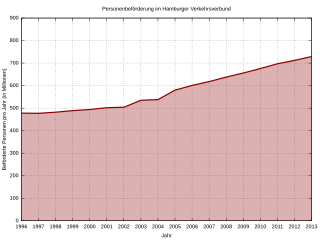
The Hamburger Verkehrsverbund (HVV) is a transport association coordinating public transport in and around Hamburg, Germany. Its main objectives are to provide a unified fare system, requiring only a single ticket for journeys with transfers between different operating companies, and to facilitate and speed up travel by harmonising the individual companies' schedules. At its inception in 1965, the HVV was the first organisation of its kind worldwide.

Hamburger Hochbahn AG (HHA), founded in 1911, operates the underground system and large parts of the bus system in Hamburg, Germany.
Metronom Eisenbahngesellschaft mbH is a German non-entirely-state-owned railway company based in Uelzen, Lower Saxony since December 2005. The company's activities focus exclusively on passenger transport, operating services from Hamburg to Bremen, Lüneburg and Uelzen, and from Uelzen to Hannover and Göttingen. Services listed on the timetables are abbreviated ME. Furthermore, the company operates services from Wolfsburg to Hannover and Hildesheim under its other brand Enno.

AKN Eisenbahn GmbH operates railway lines, commuter trains and freight trains in Hamburg and Schleswig-Holstein. Its headquarters is in Kaltenkirchen. It is a member of the Hamburger Verkehrsverbund (HVV), which organises public transport in and around Hamburg.
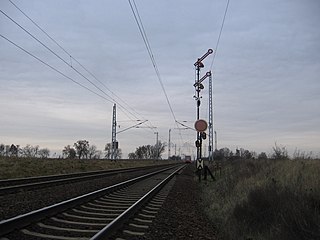
The Berlin Northern Railway is a 223-kilometre-long main line route, that runs from Berlin via Neustrelitz and Neubrandenburg to Stralsund on the Baltic Sea coast. Nowadays, long-distance and regional traffic on the Nordbahn is routed at Hohen Neuendorf onto the Berlin Outer Ring to the Karower Kreuz and on to Berlin Main Station or Berlin-Lichtenberg.

The South German Railway Company or SEG was founded on 11 February 1895, in Darmstadt by the railway entrepreneur, Herrmann Bachstein, and several bank managers.
The Osthannoversche Eisenbahnen AG (OHE) is a Celle based transportation company with railway network in North-eastern Lower Saxony around the Lüneburg Heath area of over 250 km.
The Lower Saxon State Railway Office or NLEA was a central authority that managed the operation of many light railways in the North German state of Lower Saxony. These were predominantly those railways which the state had a financial stake in.
The Celle–Wittingen Light Railway was founded on 21 June 1902 by the Prussian state, the town of Celle and 33 municipalities. On 15 August 1904 it opened the 51 km long, standard gauge line from Celle Stadt (Nord) via Beedenbostel and Hankensbüttel to Wittingen West. This line was also called the Lachte Valley Railway (Lachtetalbahn) because part of it ran along the river Lachte. The journey time on the Celle–Wittingen line in 1906 was about 2 hours and 20 minutes. In 1908 the station at Wittingen West was moved to the east side of the state station in order to enable a common station to be created with the Kleinbahn Wittingen-Oebisfelde, opened in 1909, and the Kleinbahn Bismark-Gardelegen-Wittingen, later the Altmärkische Kleinbahn AG. The new route made the construction of embankments and a bridge over the state railway necessary.

The Busenbach–Ittersbach railway is a line in the northern Black Forest in the German state of Baden-Württemberg. The mostly single-track and continuously electrified line branches in Waldbronn-Busenbach from the Alb Valley Railway —with which it is closely linked operationally and historically—and runs as a branch line to Ittersbach. The Albtal-Verkehrs-Gesellschaft is responsible for the railway infrastructure and is the only company operating on the 14.4 kilometre-long line. Originally the Busenbach–Ittersbach railway was operated together with the Ittersbach to Pforzheim line, which later became the Pforzheim Light Railway. The whole line from Busenbach to Pforzheim was initially built to 1,000 mmmetre gauge, later the section from Busenbach to Ittersbach was rebuilt to 1,435 mmstandard gauge and the Pforzheim Light Railway was closed. The line has been operated as part of line S 11 of the Karlsruhe Stadtbahn since 1994.

Hessische Landesbahn is a regional transport company owned by the German state of Hesse, based in Frankfurt am Main. It provides bus and rail passenger transport services and, to a lesser extent, rail freight services in Hesse and across the state’s borders through its subsidiaries and affiliates.
A number of narrow-gauge lines survive, largely as a consequence of German reunification, in the former East Germany where some of them form part of the public transport system as active commercial carriers. Most extensive of those still employing steam traction is the Harz mountain group of metre-gauge lines, the Harzer Schmalspurbahnen. Other notable lines are the Zittau–Oybin–Jonsdorf line in Saxony, the Mollibahn and the Rügensche Kleinbahn on the Isle of Rügen on the Baltic coast and the Radebeul-Radeburg line, Weisseritztalbahn in the suburbs of Dresden. Although most rely on the tourist trade, in some areas they provide significant employment as steam traction is particularly labour-intensive.
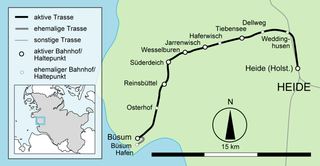
The Heide–Büsum railway is a line in the Dithmarschen district in the German state of Schleswig-Holstein, connecting the district seat of Heide with the North Sea resort of Büsum.
The Neumünster–Heide railway is a single-track, non-electrified railway line the German state of Schleswig-Holstein, connecting the city of Neumünster in central Holstein and Heide, the seat of the district of Dithmarschen.
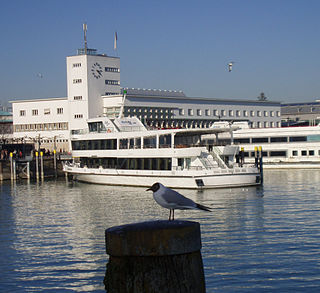
The Friedrichshafen Stadt–Friedrichshafen Hafen railway is a standard gauge and non-electrified railway line in the city of Friedrichshafen in the German state of Baden-Württemberg. It connects the town station with the port station. The 816 metre-long branch line has its own VzG route number, 4531, although operationally it is a connection between two parts of the same station.
NiedersachsenBahn GmbH is a railway company (EVU) which acts as an operating company for metronom Eisenbahngesellschaft. It is a joint venture of the private Osthannoversche Eisenbahnen AG (OHE) (60%) from Celle, Germany and the state-owned Eisenbahnen und Verkehrsbetriebe Elbe-Weser GmbH (EVB) (40%) from Zeven, Germany. The company is also based in Celle.
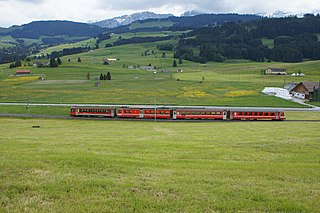
The Gossau–Wasserauen railway line is a metre-gauge adhesion railway of the Appenzell Railways. It runs from Gossau via Appenzell to Wasserauen in Switzerland and is given the abbreviation of GAW by the operator. The connection was built and electrified in several stages by different companies and has been operating continuously since 1949.
The Prussian G 4.2 was a class of compound 0-6-0 goods locomotive of the Prussian State Railways. It was a compound version of the G 3 and G 4.1 types by Henschel.